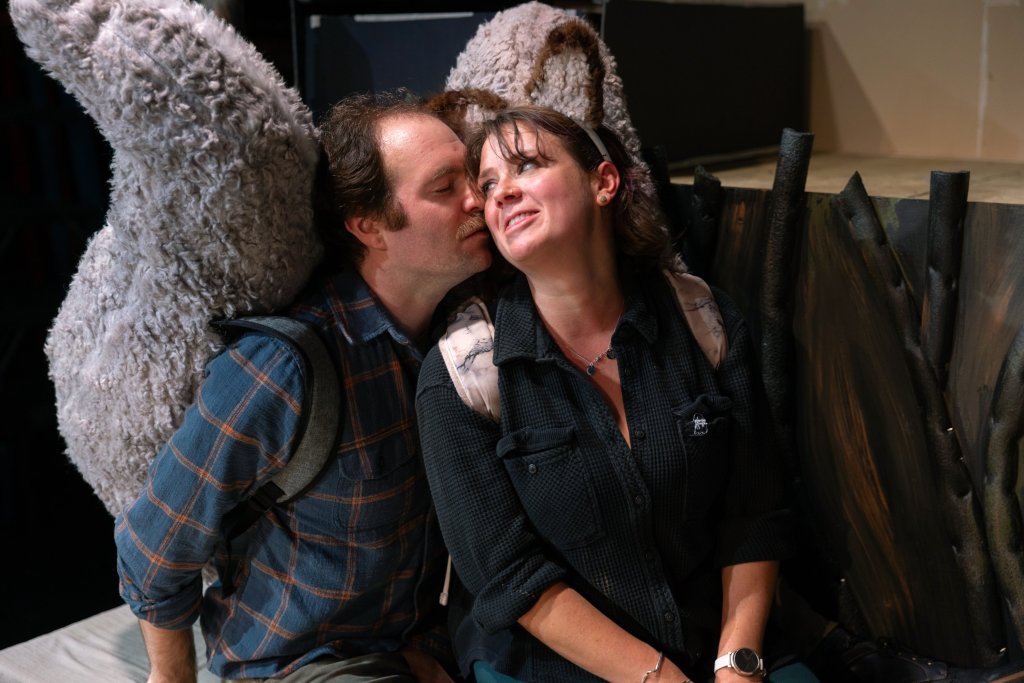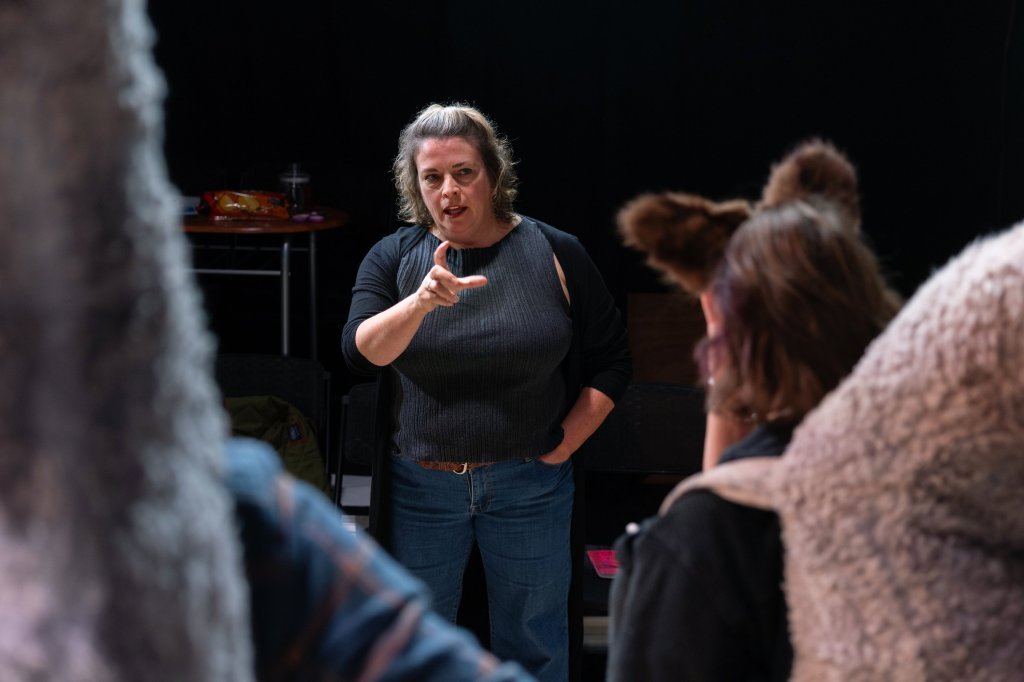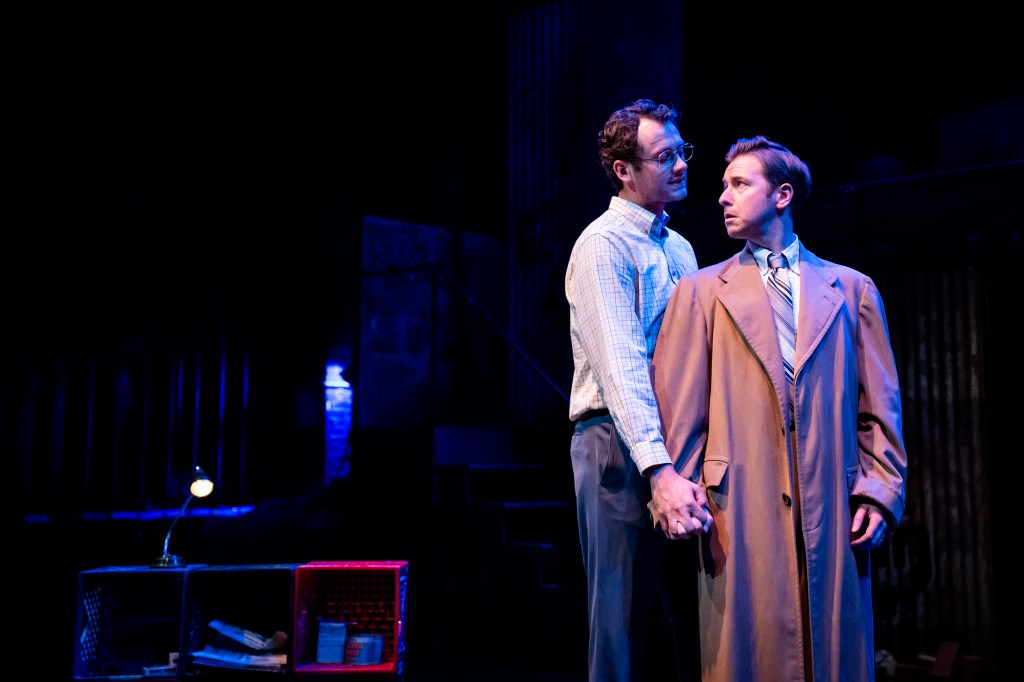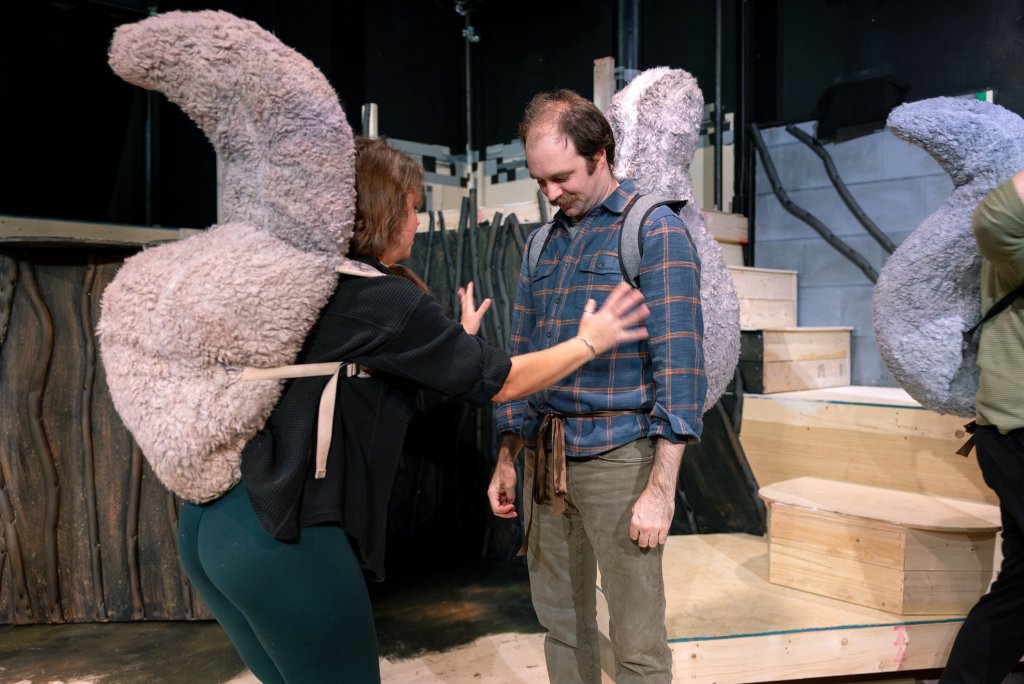
SOUTH PORTLAND — Marie Stewart Harmon wanted to know if it would make sense to have a little more nose contact.
In this particular scene of Robert Askins’ play “The Squirrels,” Harmon is trying to seduce another squirrel, in ways that might not make sense for humans. She’d already rehearsed tickling his ribs.
She asked Andrew Sawyer if he’d be comfortable with her nosing in on him, and then asked the play’s intimacy choreographer, Janice Gardner, if the move would make sense for the role.
“If nose nuzzling is closer to love for squirrels, then I’m wondering if I can come to your nose a little bit more?” Harmon asked Sawyer. “I’ll be kind of low because of the rib tickle, so I’ll be crawling up you.”
“The Squirrels,” at Mad Horse Theatre in South Portland Thursday through Nov. 23, is one of a growing number of Maine theater productions to feature an intimacy director — sometimes called an intimacy coordinator or intimacy choreographer — whose focus is to carefully plan and stage moments of physical contact between actors.
The goal is to make actors, including young and amateur performers, feel comfortable kissing, hugging, simulating sex or doing any number of things the script might call for. That’s achieved, the intimacy specialists say, by helping actors set boundaries and making the physical contact a well-rehearsed and predictable (to the actors) part of the scene.

“We’re talking about boundaries, asking people what they’re comfortable with and what they’re not comfortable with,” said Gardner, who is also intimacy director for University of Southern Maine theater productions.
The work is similar to that of fight directors, who have long been brought in to make sure fight scenes are safe and predictable.
The job of intimacy director is less than a couple of decades old, but demand shot up around 2017 during the #MeToo movement and continued to grow after the pandemic, for films, TV shows and theater productions.
“Game of Thrones” star Emilia Clarke has spoken publicly about the the lack of an intimacy coordinator on that show and the pressure she felt while filming nude scenes. Blake Lively filed a civil complaint last year against co-star and director Justin Baldoni, accusing him of sexual harassment during the filming of the romantic drama “It Ends with Us.” Lively’s lawyers said she was filmed for intimate scenes that had not been choreographed.
There are organizations that teach and certify intimacy directors and choreographers, including Intimacy Directors and Coordinators and the Intimacy Professionals Association. SAG-AFTRA, the union representing film and television actors and other media professionals, adopted a set of guidelines in 2020.
COMING TO A THEATER NEAR YOU
Maine theater companies, including college, community and professional groups, have increasingly hired intimacy directors in recent years. Hollie Pryor, who started doing intimacy work with local theaters around 2019, says she probably works on six to 10 productions a year.
She was the intimacy coordinator for the Cole Porter musical “Anything Goes” at Portland Players in South Portland in September and for parts 1 and 2 of “Angels in America” at Portland Stage in 2024.

Gardner has worked regularly with Mad Horse and USM productions. Besides working this fall on “The Squirrels,” a dark satire about wealth inequality, she helped stage intimate moments for the musical “It Shoulda Been You” at Good Theater in Portland in October.
Local actors say they often see scripts that say something like “and then they kiss” without saying who kisses who, how long the kiss should last or where the actors’ hands should be. An intimacy director takes the guess work out of it by helping plan out the interaction, step by step.

Isabelle Grignon, an actor who worked with Pryor in “Next to Normal” at Lyric Music Theater in South Portland this fall, says intimacy direction helps her feel a lot more comfortable and confident when performing. She remembers being “terrified” before her first on-stage kiss when she was about 15, in a high school production at Maine Central Institute in Pittsfield.
“Kissing in front of people is about the most embarrassing thing you can do when you’re 15. I would have loved to have had an intimacy director then,” said Grignon, now 23.
During the rehearsal at Mad Horse, Gardner had each actor point to parts of their bodies and say either green, red or yellow. Green means the area’s fine to touch, red means don’t touch and yellow means it’s up for discussion.
When Stewart and one of her scene partners, Jared Mongeau, went through the exercise, most areas were green, except one especially private area. Mongeau’s feet were a yellow — he’s never liked people touching his feet.
Gardner also had each actor rinse their mouths with a combination of mouthwash and hydrogen peroxide before rehearsal, to prevent the spread of germs and make any contact more sanitary.

CREATING ILLUSIONS
Pryor says that each play she’s worked on presents different challenges. “Angels in America” dealt with the AIDS crisis in the ’80s and there was a scene of simulated oral sex, with one actor standing and facing the audience and the other kneeling with his back to the audience.
The positioning and lighting of the actors were crucial to creating an illusion for the audience, Pryor said.
“We had them move their bodies and hands in certain ways that made it look like something was happening, when it wasn’t,” said Prior.
Another scene involved Nate Stephenson slipping his hand into some very high-waisted and loose fitting pants, worn by actor Joseph Bearor as he faced the audience.
Stephenson pressed his hand against the fabric of the pants and away from Bearor’s body, out of view of the audience.
“For me I think the thing I find most valuable about intimacy direction is how it can clinicalize and desexualize the language,” said Stephenson, 29, of Portland. “Instead of kissing, it’s lip to lip contact. Instead of butt, it’s back of the pelvis. It kind of destigmatizes things and lets you get right to the action.”
